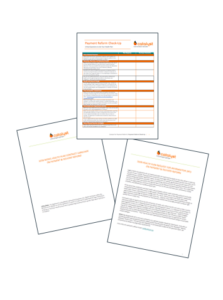Early findings from the Vitals for Change Scorecard, a guide for employers from Mercer and Catalyst for Payment Reform
Frustration with the US health care system is mounting. There’s a disconnect between what we spend and what we get in terms of high-quality outcomes and a good patient experience.
Employers have the power to change that. They provide health care to a majority of Americans and their combined influence and purchasing power could move the market toward higher quality and less waste. The Vitals for Change framework calls on employer health plan sponsors to demand more for their employees and their families in four key areas that target systemic problems in the health care system and drive positive disruption and innovation.
To amplify this message, Catalyst for Payment Reform and Mercer partnered to create the Vitals for Change Scorecard, a free assessment and benchmarking tool that helps employers identify how to optimize their health benefits programs.
More than 30 employers have completed the Scorecard since it launched last month. Although the database is still small (but growing fast!), we reviewed the early responses for a first snapshot of how things stand in each of the four Vitals for Change areas. While these findings are preliminary and can’t be considered representative, they suggest that some employers are starting to shake up the status quo. Here are some highlights.
Vital 1: Pay for value – Reimburse providers based on quality and outcomes, not volume
- Of eight forms of alternative provider payment methods, the one used most commonly by respondents’ health plans (47%) is shared savings, in which there is an upside-only financial incentive for providers to reduce unnecessary healthcare spending for a population of patients or episode of care.
- Over half of the Scorecard respondents (56%) use benefit incentives to steer employees to high-value providers.
- About a fourth (28%) offer a narrow network of high-value providers.
Vital 2: Drive to quality – Steer members to high-quality care using data, technology and user insights
- The most common way these employers encourage plan members to refer to quality information before selecting a provider is by listing the highest-quality providers and facilities first in directories (45%). Just 10% provide a one-time incentive to members that review and use provider quality information – and none require that members review quality information before accessing benefits.
- Nearly half the employers (47%) provide employees with a health advocacy service to steer members to high-quality providers. And over a third will only cover certain services if they are obtained in a specified center of excellence or other high-quality setting.
Vital 3: Personalize the experience – Build engagement by providing choice and customizing member interactions
- The Scorecard asks whether senior leadership considers programs encouraging employee engagement with health and well-being to be an important means of achieving overall HR and business objectives. Well over half of the respondents (58%) say senior leadership considers these programs very or moderately important. Just 10% believe senior leadership doesn’t see a connection.
- About one-third of Scorecard users make efforts to understand what the different workforce segments or demographic groups value in terms of benefits, programs and policies.
Vital 4: Embrace disruption – Seek out opportunities in the rapidly changing health care ecosystem to work together to change the status quo
- Over half of Scorecard participants (55%) are members in a local or regional business health group that has the goal of improving health care affordability and quality – and 23% say they are highly engaged in the organization.
- The Scorecard lists about a dozen disruptive innovations, ranging from genetic therapies to companion robots, and asks users to rate their potential for positive change. The two most highly rated were connected medical devices in the home for remote monitoring and blockchain.
We are just beginning to delve into the data to understand how employers today are acting as change agents. Employers who take the Vitals for Change Scorecard will receive a quick tutorial on transformative health care strategies.
Many of the practices listed are only just now becoming actionable, so employers, be forewarned: If you take the Scorecard, don’t expect to check most — or even many — of the boxes! But you will come away with a better sense how your organization’s approach fits with where the market is going.
Click here to learn more about the Vitals for Change Scorecard!
About Catalyst for Payment Reform
Catalyst for Payment Reform is an independent, non-profit organization working on behalf of large employers and other health care purchasers to catalyze employers, public purchasers and others to implement strategies that produce higher-value health care and improve the functioning of the health care marketplace. For more information visit: cprstagingsite.wpengine.com and follow us on LinkedIn and Twitter.
# # #
Media Contact:
Cary Conway
972.649.4707

